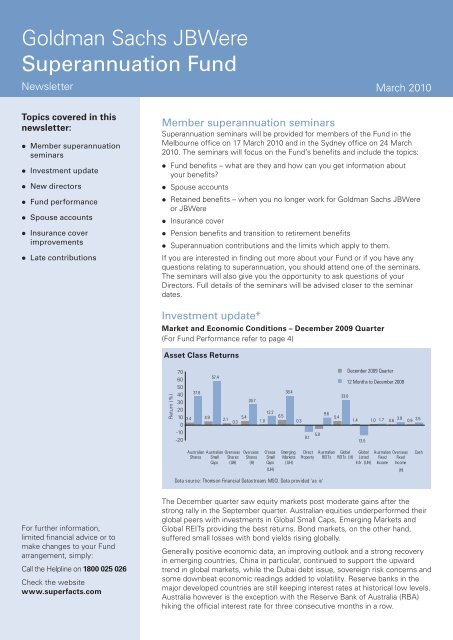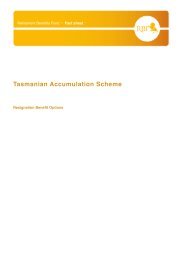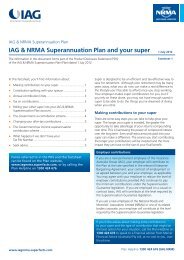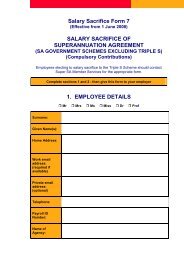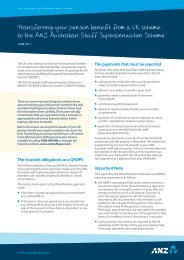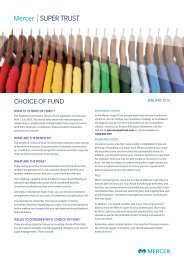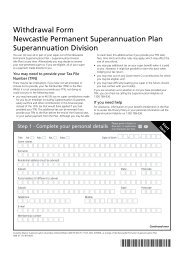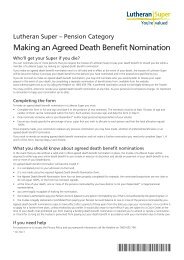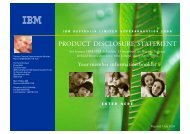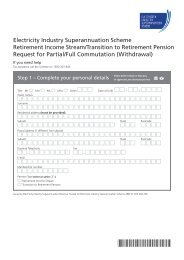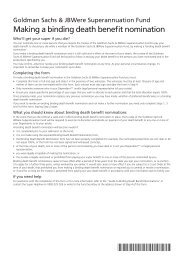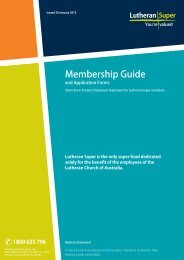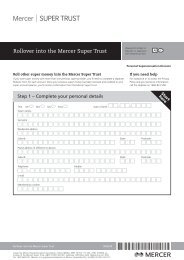Goldman Sachs JBWere Superannuation Fund - SuperFacts.com
Goldman Sachs JBWere Superannuation Fund - SuperFacts.com
Goldman Sachs JBWere Superannuation Fund - SuperFacts.com
You also want an ePaper? Increase the reach of your titles
YUMPU automatically turns print PDFs into web optimized ePapers that Google loves.
<strong>Goldman</strong> <strong>Sachs</strong> <strong>JBWere</strong><strong>Superannuation</strong> <strong>Fund</strong>NewsletterMarch 2010Topics covered in thisnewsletter:•zMember superannuationseminars•zInvestment update•zNew directors•z<strong>Fund</strong> performance•zSpouse accounts•zInsurance coverimprovements•zLate contributionsMember superannuation seminars<strong>Superannuation</strong> seminars will be provided for members of the <strong>Fund</strong> in theMelbourne office on 17 March 2010 and in the Sydney office on 24 March2010. The seminars will focus on the <strong>Fund</strong>’s benefits and include the topics:•z<strong>Fund</strong> benefits – what are they and how can you get information aboutyour benefits?•zSpouse accounts•zRetained benefits – when you no longer work for <strong>Goldman</strong> <strong>Sachs</strong> <strong>JBWere</strong>or <strong>JBWere</strong>•zInsurance cover•zPension benefits and transition to retirement benefits•z<strong>Superannuation</strong> contributions and the limits which apply to them.If you are interested in finding out more about your <strong>Fund</strong> or if you have anyquestions relating to superannuation, you should attend one of the seminars.The seminars will also give you the opportunity to ask questions of yourDirectors. Full details of the seminars will be advised closer to the seminardates.Investment update*Market and Economic Conditions – December 2009 Quarter(For <strong>Fund</strong> Performance refer to page 4)Asset Class ReturnsReturn (%)706050403020100-10-2037.63.4 4.957.42.10.35.426.712.21.06.538.40.39.15.09.6December 2009 Quarter12 Months to December 200933.05.41.4 1.0 1.7 0.63.90.93.513.5AustralianSharesAustralianSmallCapsOverseasShares(UH)OverseasShares(H)O'seasSmallCaps(UH)EmergingMarkets(UH)DirectPropertyAustralianREITsGlobalREITs (H)GlobalListedInfr. (UH)AustralianFixedIn<strong>com</strong>eOverseasFixedIn<strong>com</strong>e(H)CashData source: Thomson Financial Datastream; MSCI. Data provided 'as is'For further information,limited financial advice or tomake changes to your <strong>Fund</strong>arrangement, simply:Call the Helpline on 1800 025 026Check the websitewww.superfacts.<strong>com</strong>The December quarter saw equity markets post moderate gains after thestrong rally in the September quarter. Australian equities underperformed theirglobal peers with investments in Global Small Caps, Emerging Markets andGlobal REITs providing the best returns. Bond markets, on the other hand,suffered small losses with bond yields rising globally.Generally positive economic data, an improving outlook and a strong recoveryin emerging countries, China in particular, continued to support the upwardtrend in global markets, while the Dubai debt issue, sovereign risk concerns andsome downbeat economic readings added to volatility. Reserve banks in themajor developed countries are still keeping interest rates at historical low levels.Australia however is the exception with the Reserve Bank of Australia (RBA)hiking the official interest rate for three consecutive months in a row.
GOLDMAN SACHS JBWERE SUPERANNUATION FUNDOverall global bond yields rose during the quarter with theimprovement in the global economic recovery, but highervolatility was also witnessed, as safe-haven flows andfading interest rate hike expectations in the US and Europedampened bond yields in November. The longer end ofthe Australian yield curve moved upwards in line withglobal peers while the shorter end of the curve reactedto positive economic data but was also kept down bynon <strong>com</strong>mittal rate rise <strong>com</strong>ments by the RBA. Althoughthe spread between Australian and US 10 year bondyields narrowed to 185bps, and the USD rallied stronglyagainst all major currencies in December, over the quarterthe Australian dollar still managed to appreciate 1.9%against the US dollar and 2.2% as measured by the TradeWeighted Index.Key developments during the quarter•zThe RBA delivered three consecutive rate hikesduring the quarter each with an equal amount of25bps, which raised the cash rate from a historicallow of 3.00% to 3.75%. Minutes from the RBAboard meetings continued to reveal its increasingconfidence in the global and domestic economicrecovery, as well as concerns that the monetarystimulus put in place during the extreme marketconditions may no longer be suitable in the currentenvironment.•zAustralian economic data was mixed over thequarter. The Australian labour market has beenshowing strong signs of a recovery, with the level ofemployment jumping up three months in a row andthe unemployment rate falling to 5.7% in November.The housing sector and business confidence surveysboth delivered upbeat results. However Q3 GDPrecorded a 0.2% increase quarter on quarter, whichwas below market expectations of 0.4%. Thisbrought the annual growth rate in at 0.5%. Consumerconfidence fell in November and December,attributable to rising interest rates. The trade deficitwidened with the October reading standing at$2.4 billion.•zThe US Federal Open Market Committee left thecash rate target unchanged at 0% - 0.25%, notingthat “economic conditions, including low rates ofresource utilization, subdued inflation trends, andstable inflation expectations, are likely to warrantexceptionally low levels of the federal funds rate foran extended period”. The Federal Reserve is alsoin the process of purchasing $1.25 trillion of agencymortgage-backed securities and about $175 billionof agency debt in order to support the US mortgagelending and housing markets and to improve overallconditions in private credit markets. The Bank ofEngland also maintained the bank rate at 0.5%throughout the quarter.•zUS economic data released over the period wasmixed but with more positive news near the endof the period. The annualised figure for Q3 GDPwas revised down from 3.5% to 2.2%. The officialunemployment rate eased marginally to 10.0%after touching a new high of 10.2%, while the ADPemployment figures continued to disappoint themarket. Conversely, the housing figures were strongthroughout the quarter. November non-farm payrollsprovided an upbeat surprise to the market with a dropmuch less than forecasted. Consumer confidenceand retail sales both increased over the quarter.•zIn late November, Dubai’s state holding <strong>com</strong>panyDubai World, which has a liability of US$60 billion,asked creditors for a “standstill” agreement as itnegotiated to extend debt maturities. Some creditrating agencies also announced a revised outlookfor the sovereign ratings of some European nationsincluding Greece and Spain, highlighting concernsover their fiscal positions.•zThe price of oil (WTI) rocketed up 12.8% over thequarter closing at US$79.67/barrel, benefiting fromthe continuing global economic recovery and a betterdemand outlook.•zThe gold price surged strongly over the quarter,touching US$1200/oz before pulling back with theappreciation of the greenback in December, endingthe quarter 8.8% higher at US$1096/oz.Australian sharesFollowing the substantial increase during the Septemberquarter, the Australian share market posted a moremoderate gain during the December quarter. Localeconomic data continued to provide solid support for thedomestic market, while rising base metal prices saw theresources sector as a major contributor to the index gain.Conversely, some downbeat economic readings fromthe US and UK in October, profit taking from the financialsector and sovereign risk concern in some countriesprovided a drag to the local market. The S&P/ASX 300rose 3.4% over the quarter and 37.6% for the year, whileSmall caps (+4.9%) outperformed their Large (+3.3%) andMid cap (+2.5%) counterparts and the broader index.With ongoing strong Chinese economic data and rising<strong>com</strong>modity prices, Materials (+13.9%) was the only sectordelivering double digit returns over the quarter. Defensivesectors Utilities (+5.4%) and Consumer Staples (+4.7%)were also in favour. In contrast, Financials (ex LPT)(-0.6%), provided a drag to the index, suffering from profittaking amid concerns over the European banking sectorand the possibility of global regulatory change. PropertyTrusts (-5.0%) and Energy (-2.5%) topped the worstperforming sectors.Strong performance in the resources sector saw BHP(+15.1%) and RIO (+26.9%) lead the positive contributorslist, followed by Wesfarmers (+19.2%) benefiting fromrobust sales growth. Conversely, big banks were underpressure with NAB (-9.7%) being the worst contributor.2
GOLDMAN SACHS JBWERE SUPERANNUATION FUND<strong>Fund</strong> performanceA summary of the <strong>Fund</strong>’s monthly crediting rates since 1 July 2009** is set out in the following table. The returns on theMercer Employer Super Balanced Growth Survey (the <strong>Fund</strong>’s benchmark) have been included for <strong>com</strong>parison.MonthCrediting rate for the month*Mercer Employer Super Balanced GrowthSurvey Balanced Median for monthJuly 2009 6.37% 3.9%August 2009 4.24% 3.8%September 2009 4.72% 2.8%October 2009 -0.81% -1.3%November 2009 0.79% 1.2%December 2009 3.48% 2.1%January 2010 -3.80% -2.1%7 Months to31 January 2010* Account Based Pension crediting rates are available on the website www.gsjbw.superfacts.<strong>com</strong>15.56% 10.69%**It is very important to note that past performance is not a reliable indicator of further performanceGiven the significant market volatility in recent months, it is important to remind Members that superannuation is along term investment. Under the <strong>Fund</strong>’s Investment Strategy, our investment objective is to provide a five year rollingnet return that is equal to or above the median of balanced pooled investment managers, as measured in the MercerEmployer Super Balanced Growth Survey over a five year rolling average. The following table* demonstrates the <strong>Fund</strong>’sstrong performance relative to the benchmark over the longer term (5 and 10 years)**.430June200030June200130June200230June200330June200430June200530June200630June200730June200830June2009Average5 yearreturn paCrediting Rate 15.4 13.6 -1.7 2.2 13.6 22.1 23.7 18.1 -7.2 -6.7 9.1 8.7Benchmark* 11.2 5.5 -3.9 -0.8 13.0 13.0 15.7 14.6 -9.4 -13.9 3.7 4.3* Mercer Employer Super Balanced Growth SurveyRemember that you can look up the <strong>Fund</strong>’s most recent crediting rates on the <strong>Fund</strong> website www.superfacts.<strong>com</strong>,at any time.Average10 yearreturn paSpouse accountsIf you are a permanent employee and a member of the <strong>Fund</strong>, your spouse can apply to be<strong>com</strong>e an Eligible Spouse Member.Eligible Spouse Member means:•za member’s husband, wife, widower or widow;•zanother person (whether of the same sex or a different sex) with whom the person is in a Registered Relationship; or•zanother person who, though not legally married to the person, lives with the member on a genuine domestic basis in arelationship as a couple.An Eligible Spouse Member’s account can be credited with contributions (concessional and non-concessional) made bythe Spouse Member or their spouse (i.e. the original member), amounts transferred from another superannuation fund,allocations from a contribution split, and investment earnings (if positive). Deductions for tax, fees, insurance premiums andnegative investment earnings will be made from the account.Spouse Members may apply for voluntary death only insurance cover or voluntary death and Total and PermanentDisablement insurance cover.Please refer to your Product Disclosure Statement (see the website www.gsjbw.superfacts.<strong>com</strong> for the current version) formore information.The application form to be<strong>com</strong>e an Eligible Spouse Member can be found on the <strong>Fund</strong>’s website under Membership Formsin the Documents and Forms menu. Alternatively you can call the Helpline on 1800 025 026 and they will send you the form.The Trustee re<strong>com</strong>mends that you seek financial advice before setting up an Eligible Spouse account.
MARCH 2010Insurance cover improvementsThe <strong>Fund</strong> provides Death, Total and Permanent Disablement (TPD) and Salary Continuance insurance cover (if yoube<strong>com</strong>e totally but temporarily disabled). Most employees have access to automatic Death and TPD cover and SalaryContinuance cover. In addition, most members can apply for voluntary Death, TPD and Salary Continuance cover.The following table summarises the insurance cover:<strong>Fund</strong> DivisionBenefits Plus<strong>Superannuation</strong>GuaranteeAutomatic Death & TPD Voluntary Death & TPD Automatic SalaryContinuance Insurance18% x Final AverageSalary x Complete Yearsand Months to Age 65.(eg if you are age 50and your Final AverageSalary is $50,000 yourinsurance cover will be$135,000.)10% x Salary xComplete Years andMonths to Age 65.(eg if you are age 50 andyour salary is $50,000your insurance cover willbe $75,000.)Units of $50,000 withan unlimited maximumfor Death cover and $3million of TPD cover.(Maxima include anyautomatic cover.)Casual Not available Units of $50,000 withan unlimited maximumfor Death cover and $3million of TPD cover.Spouse Not available Units of $50,000with a maximum $1million of Death coverand $500,000 of TPDcover.RetainedEqual to the level ofDeath & TPD cover youhad on your last day ofemployment (reducesfrom age 50 to $0 at age65).Units of $50,000 withan unlimited maximumfor Death cover and $3million of TPD cover.(Maxima include anyautomatic cover.)75% of In<strong>com</strong>epayable for 24 months.In<strong>com</strong>e = TotalEmployment CostplusAverage of yourbonuses over the prior2 years.Not availableEqual to the level ofSalary Continuancecover you had onyour last day ofemployment.Voluntary SalaryContinuance InsuranceUp to a total maximumcover of $360,000 paor $30,000 per month.Not availableUp to a total maximumcover of $360,000 paor $30,000 per month.The summary above provides only an overview of the insurance benefits available in the <strong>Fund</strong>. Further details abouteligibility, levels of insurance cover and premiums for each Division are set out in the Product Disclosure Statement forAccumulation Benefits which is available on the <strong>Fund</strong> website.How to apply for or vary your insurance coverIf you are not sure what insurance you have please check online at www.gsjbw.superfacts.<strong>com</strong> or check your mostrecent member statement (also available online).To apply for or vary your voluntary cover (increase or decrease) you need to <strong>com</strong>plete the Additional Voluntary InsuranceCover form which is available on the website or by contacting the Helpline on 1800 025 026.If you are increasing or initiating additional cover, you will be required to provide evidence of good health. The Insurer(AIA Australia Limited) will assess your application and may request additional evidence. Once the Insurer has madea decision on your application you will be informed in writing. Until that time the additional cover is not in place andpremiums for the cover will not be deducted from your account.5
GOLDMAN SACHS JBWERE SUPERANNUATION FUNDRecent insurance improvementsThe <strong>Fund</strong> has recently negotiated improvements to the<strong>Fund</strong>’s insurance arrangements. Some improvementsinclude:•z30% reduction in Salary Continuance Insurancepremiums – back dated to 1 July 2009.•zIncrease in the level of automatic Salary ContinuanceInsurance cover from 1 January 2010. This means thatmembers whose cover was previously restricted by theold maximum have now automatically been increased inline with the new maximum.•zUnderwriting requirements have been simplified. Thismeans that when you apply for any cover or an increasein cover, the insurer’s health evidence requirements formost levels of cover have been eased.If you would like to take advantage of these improvementsby applying to take out or increase cover, please visit thewebsite www.gsjbw.superfacts.<strong>com</strong> or call the Helplineon 1800 025 026 for more information.Late contributionsAs a result of the implementation of a new payroll systemat <strong>Goldman</strong> <strong>Sachs</strong> <strong>JBWere</strong>, there were some delays in theremittance of some contributions to the <strong>Fund</strong> by <strong>Goldman</strong><strong>Sachs</strong> <strong>JBWere</strong> in August and September 2009. <strong>Goldman</strong><strong>Sachs</strong> <strong>JBWere</strong> has agreed to <strong>com</strong>pensate members inrespect of lost earnings due to the delay. As a result anadditional interest amount will be credited to affectedmembers accounts in March 2010. This will appear asan additional interest transaction in your next MemberStatement and will be reflected in transactions which canbe reviewed in your account on the website.*Data source: Mercer (Australia) Pty Ltd.† It is very important to note that past performance is not a reliable indicator of future performance.§ you be<strong>com</strong>e a “lost” member if two consecutive Annual Reports that have been sent to you are returned to the <strong>Fund</strong> unclaimed.6
MARCH 2010Important Note:This newsletter is provided by Mercer (Australia) Pty Ltd ABN 32 005 315 917 (Mercer) which is a corporate authorised representative of Mercer Investment NomineesLimited ABN 79 004 717 533, AFS License No. 235906. Mercer has been appointed by BEST <strong>Superannuation</strong> Pty Ltd ABN 57 070 732 008, the trustee of the<strong>Goldman</strong> <strong>Sachs</strong> <strong>JBWere</strong> <strong>Superannuation</strong> <strong>Fund</strong> ABN 55 697 537 183 (<strong>Fund</strong>), to provide general financial product advice to <strong>Fund</strong> members.The newsletter has been prepared for the general information of <strong>Fund</strong> members. The information and any advice in this newsletter is for educational purposes andgeneral information only and has been prepared without taking into account any member’s individual objectives, financial situation or needs. Therefore, before acting onany information contained in this newsletter, you should consider its appropriateness having regard to your objectives, financial situation and needs and you may wish toseek professional advice from a licensed or appropriately authorised financial adviser that takes account of your situation before making any decisions about your super.Any statements of law or proposals are based on Mercer’s interpretation of the law or proposals as at 15 March 2010.While all due care and diligence has been taken in the preparation of this newsletter, Mercer and the Trustee reserve the right to correct any errors or omissions. Ifthere are any inconsistencies between the terms of the <strong>Fund</strong>’s trust deed and this newsletter, the terms of the trust deed prevail. Also, if there are any inconsistenciesbetween group insurance policies held by the Trustee and this newsletter, the terms of the policies prevail.BEST <strong>Superannuation</strong> Pty Ltd ABN 57 070 732 008, trustee of the <strong>Goldman</strong> <strong>Sachs</strong> <strong>JBWere</strong> <strong>Superannuation</strong> <strong>Fund</strong> ABN 55 697 537 183, (Trustee).ME755_146124_2010037


